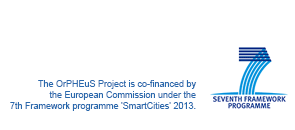Reports
- Technical, Economical and Social benefits
- Monitoring and System analysis
- System modelling and Simulation for the Evaluation of the OrPHEuS Control Strategies
- Cooperative Control Strategies
- Demonstration of Project outcomes
- Project results: Evaluation and Conclusions
- Communication and Dissemination of Project results
Technical, Economical and Social benefits
This report provides a qualitative description of energy service provision. The historical development of energy networks in dense areas is outlined and various factors determining the patterns of energy distribution grids are demonstrated, investigated and categorized into technological, economic and social influences. Finally several matrices are presented, providing a structure for describing the status quo and outlook of energy service provision in hybrid networks.
This reports links the project’s technical findings to economic parameters for the investigated present and future scenarios at the two demonstration sites. The methodology used for the economic modelling is outlined and the economic impacts of implementing hybrid energy grids are estimated. Suitable business models benefitting all market actors are proposed while possible regulatory issues are highlighted. For each scenario the most important findings are identified, the implications for different market participants are explained and major conclusions are presented.
Monitoring and System analysis
This report describes a reference M2M platform design, identifies and concretizes project-related challenges, and designs four platform extensions (self-configuration, consumer behavior analysis, data filtering, and M2M cloud systems) for tackling the identified challenges, while it also examines further ICT tasks. Finally, it discusses the (future) usage or evaluation of these extensions in conjunction with other WPs. Two of the most important M2M platform-related tasks of OrPHEuS are:
- Smart data filtering of OrPHEuS data (i.e., hybrid energy grid data)
- Examination of hybrid energy grid control systems as part of Smart City Operation Centers (and their integration into the latter)
The report provides ICT-related recommendations for future energy monitoring and control systems, as well as their integration into more widely scoped Smart City systems and Smart City Control Centers. Firstly, an analysis of “further” ICT/M2M or Smart City-related data sources that could be used for energy control optimization is provided. Secondly, business and technical aspects are discussed and recommendations for the integration of systems like OrPHEuS into Smart City Control Centers are provided. Thirdly, a recommended solution for supporting actuation and low-latency interactions in data streaming systems such as the OrPHEuS monitoring system is described in detail.
This report gives a short introduction to the different energy grids and an overview about available technologies which are necessary for hybridization between the different energy grids. Furthermore, the nominal and dynamic parameters for the technologies are explained.
The report presents the needs for meteorological services for different stakeholders and use cases at the two demonstration sites, and describes which measurement, prediction and processing methods are the most suitable to answer these needs. The work performed within the project and its results are presented for the six investigated use cases. Furthermore recommendations are provided regarding additional meteorological information needed to enhance results for the use cases.
This document describes how the metrics required to quantify the effect of environmental conditions (solar irradiance, ambient temperature) on energy systems can be estimated by remote sensing, meteorological forecasts or simulation models. Metrics estimated with these options, denoted as virtual measurements, are validated against in-situ and ground-based measurements in Germany and Sweden. The impact of high shares of photovoltaic supply on the lifetime of local power transformers is also estimated for the demonstration site of Ulm (Germany).
System modelling and Simulation for the Evaluation of the OrPHEuS Control Strategies
The main scope of the deliverable D4.3.2 (Task 4.3) is the technical evaluation and validation of the OrPHEuS collaborative control strategies for hybrid grids under future business models. The assessment and validation of the control strategies' simulation results is performed for the two demo sites, respectively Skellefteå (Sweden) and Ulm (Germany) for different scenarios and variations. The technical evaluation ensures that the proposed hybrid energy grid approach does not result in violations of operational limits at the demonstration sites, such as line voltage in the electric grid, or in undesirable side-effects such as heat losses in the district heating grid. Additionally a theoretical assessment of the integration of a power-to-gas device as an additional coupling point at the Ulm demonstration site is included.
This document will be published after validation by the European Commission.
Cooperative Control Strategies
This report describes the investigated future hybridization scenarios and presents the associated simulation results for the two demonstration sites of Ulm (Germany) and Skellefteå (Sweden). The investigation process and results are presented from the control strategy perspective, with a comparison of different control variations corresponding to different goals such as cost minimization versus CO2 reduction. The future scenario for Ulm is an evolution of the present scenario, in which electric boilers feed into an extension of the local district heating network. In Skellefteå, the investigated future scenario sees a large industrial player with high electrical consumption and production of waste heat (such as a datacenter) built in the town’s vicinity. A heat pump and an electrical battery are proposed as coupling points between the city’s energy grids (electricity and district heating) and the industrial site to benefit from available synergies. In addition, and augmented present scenario is investigated for Ulm, in which e-boilers can produce heat for domestic hot water as well as space heating. Recommendations on control strategies are formulated based on the presented results.
This report discusses the project’s control approaches in the context of hybridization scenarios other than the ones studied throughout the project. Applicability to cities in other regions, with different energy networks, different means of energy exchange, and different supply and demand patterns is analyzed. Also addressed is the question of scalability of the control approaches to much larger scenarios, by discussing issues like computational constraints, robustness, and communication overhead.
Demonstration of Project outcomes
An online visualization tool was developed for users to easily grasp the OrPHEuS project concept as applied to the two demonstration sites of Ulm and Skellefteå. The investigated scenarios are introduced and simulation results for control and economic parameters can be displayed and explored in a simple manner. The tool is accessible on the dedicated webpage at the above link.
Project results: Evaluation and Conclusions
This report is provided as a final summary of the OrPHEuS outcomes. It evaluates the results achieved across the project, including business model design for hybrid energy grids, ICT aspects (IoT, virtual and real-life measurements, and meteorological data), simulation frameworks and control strategies. Furthermore the report outlines the consortium recommendations for replication in other European contexts with focus on technical, economic and socio-economic aspects.
Communication and Dissemination of Project results
This report summarises two interactive workshops organized at the end of the project to disseminate the OrPHEuS results relative to the demonstration sites of Ulm (Germany) and Skellefteå (Sweden). The workshops were also thought as a way to collect feedback from the participants to identify remaining barriers to the implementation of hybrid energy grids. The report includes the summary of the discussions which took place, including those related to remaining regulatory and economic barriers in the German and Swedish contexts.


